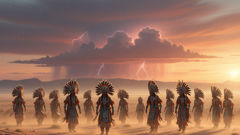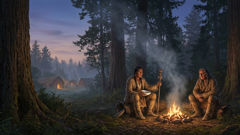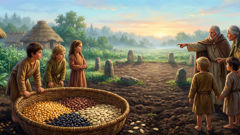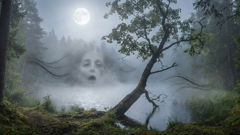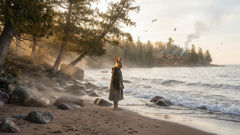Introduction
Between the long, leaning arms of ancient cedars and the salt-sweet breath of the nearby sea, stories of the Dzunukwa were told beside evening fires and under eaves carved with raven and thunderbird. She is a figure who lives in the porous space where warning becomes wonder: a wild, enormous woman with hair like tangled kelp and a voice like the scrape of bark, who eats children if she can, and yet who returns from the forest bearing boxes of shell money and carved treasures for those who show respect. To the Kwakiutl peoples—who across generations have lived with cedar, salmon, and storm—the Dzunukwa is no mere monster; she is a part of the weathered world, a spirit that tests curiosity and compassion and that can reveal the weight and worth of generosity. This retelling gathers the scent of cedar bark, the texture of salted smoke, and the cadence of oral telling to explore the Dzunukwa’s many faces: the terrifying Wild Woman who calls in the night, the foolish child who wanders toward a gap in the fog, the clever hunter who tricks a giant, and the family whose offerings become abundance. Alongside vivid descriptions of her appearance—broad nose, sagging jowls, a gap-toothed grin that can be both frightening and strangely weary—this narrative traces how the Dzunukwa has moved through time, from oral warning to theatrical figure in potlatch performances, and into contemporary stories that reckon with history, cultural continuity, and respect for Indigenous knowledge. As you read, imagine the forest as a living ledger where every act of taking or giving leaves a mark, and the Dzunukwa as a hinge between human desire and natural reciprocity. Her legend teaches more than fear: it asks readers to look at how communities steward the land, protect the young, and remember the obligations that come with inherited wealth. This is a careful, immersive account that honors the Kwakiutl roots of the tale while letting the texture of the woods and the drama of encounter unfold like a slow, deliberate drumbeat.
Origins, Appearance, and the Wild Woman’s Place in Kwakiutl Story
The Dzunukwa’s story begins in the deep, imprecise time before maps drew neat lines and before written chronicles tried to fix meaning into paragraphs. Her presence belongs to seasons and to the long practice of listening—of children put to sleep to the rhythm of wave and wing, of elders speaking of what the forest will accept and what it will not. In Kwakiutl oral tradition, the Dzunukwa is often described as a tremendous woman who lives in the woods at the edge of human settlements. Her face may be painted the color of rot or mud, her hair uncombed and laced with moss and drift, her voice a low rumble like distant thunder. She walks with unsteady steps that leave enormous prints in the moss, and her breath smells of smoke and seaweed. When described in songs and story cycles, the Dzunukwa can change: sometimes she is utterly feral, hair braided with roots and wearing skins; other times she carries the relics of civilization—shells, masks, jewelry—picked up or stolen from houses and graves.

In many accounts, she is one of those ambiguous beings that straddle categories. She is monstrous and maternal; she is dangerous and a provider. Tales told to children warn against wandering away from the path because the Dzunukwa likes to carry off the curious or disobedient, substituting silence for mischief. Parents whisper of her hands—huge, filled with calluses from hauling trees—snatching at small ankles when the firelight thins. But the stories rarely end only in punishment. The same figure who might threaten a child is also the one who appears in other tales offering riches: a folding box of shell money left on a threshold, a cedar trunk of blankets in the morning, a sudden wind that scatters a family’s seeds into safe ground. These contradictory traits are not errors in storytelling; they are the grammar of an older logic. The forest and the wild woman within it are mirrors for reciprocity. The Dzunukwa responds to the way people behave toward the land and to one another. Those who take without ceremony risk her appetite; those who give, or who show humility and bravery, may be rewarded.
Physically, the Dzunukwa’s description is vivid and specific: enormous proportions, a hunched back like an overburdened cedar, sagging skin marked with lichen-like patterns. Her mouth is often described as both grotesque and tragic—a gap-toothed grin that tells of hunger but also of loneliness. Her eyes, when the story narrows to a moment of encounter, can be piercingly human: old and tired, recording years of being shunned and, sometimes, of being taken advantage of by those who seek her hoard. In one well-known pattern of tale, a group of children hear a sound under their house and peek; the Wild Woman hears the whisper of breath and, thinking of food, lifts the house to look. The children escape by cleverness or by the intercession of an elder, but the impression remains: the wild woman is known by what she takes and by what she could give back.
Beyond physicality the Dzunukwa is woven into ritual and performance. The Kwakiutl, like other Indigenous nations of the Northwest Coast, have long used masks and dances in potlatch ceremonies to recall ancestors, to teach, and to enforce social values. In some potlatch narratives, a figure like the Dzunukwa may appear—not as an object of ridicule but as a character who embodies communal lessons about moderation, respect, and the proper conduct of generosity. Masks that suggest the wild woman’s exaggerated features are carved and used to dramatize the story: the performers exaggerate voice, movement, and the dangerous, lurching steps that shock young watchers and remind elders. Those performances reframed the Dzunukwa from a private bedtime warning to a public teaching tool: a ritualized space where the paradox of her character—both predator and provider—could be unpacked for the whole community.
Her role in these practices preserves a kind of cultural memory. In times of scarcity the notion that wealth could mysteriously appear from the forest had a moral impetus: wealth arrives not from greed but from relationships, from reciprocity with the land and with others. To this day, the Dzunukwa sits in the collective imagination as a reminder to treat the environment with ceremony and familiarity, to respect what sustains life, and to remember the fragile balance between human need and nature’s thresholds. In stories of the past, young people learned to carry tobacco, offer small gifts, and recite particular names when moving through the woods—practices designed to soften the edges of encounter with spirits like the Dzunukwa. That grammar of courtesy persists in local teachings that emphasize listening to the land: how to watch the salmon runs, where to take cedar and how much to cut without dishonor.
The Dzunukwa is not a single story but a set of stories and motifs. Across the Kwakiutl and neighboring nations there are echoes and relatives—figures who steal or test children, spirits who function as both danger and providers—that reflect a coastal cosmology where relationships matter. The emphasis is rarely on a simplistic battle of good versus evil; instead, the tales frame the world as a network of obligations. The Dzunukwa tests boundaries, and in doing so she clarifies what counts as civilized or reckless, what counts as greedy or generous. When retold by modern storytellers—Indigenous scholars, community elders, and artists—the legend has also become a way to reflect on the colonial past, to ask how outsiders misunderstood both land and people and to remind audiences that cultural survival depends on remembering protocols of respect.
At the heart of the Dzunukwa’s enduring power is this moral ambiguity. She terrifies, and she enriches. She is a living metaphor for the way forests give and withhold. The cedar stands between the village and the sea; gifts of cedar are both livelihood and ceremony. The Dzunukwa exists precisely where people must decide whether to take what the old-growth provides casually, or to participate in the slow accounting of giving back. That is the lesson carried like a shell on a string through generations: reciprocity is the hidden currency of the woodland world, and the Wild Woman is its stern accountant.
Encounters, Cautionary Tales, and the Modern Resonance of the Wild Woman
Whatever the precise origin of any single tale, the narratives of encounter are where the Dzunukwa’s lessons live. One common story type is the cautionary tale told to children: a youngster strays from a group and follows a small stream into the trees, drawn by a sound—an odd humming, a jar of small boxes clinking like distant rain. The child meets a huge, disheveled woman who speaks in a voice like wind through leaves. She seems puzzled by the child’s ease, or delighted at the novelty of a small creature who does not immediately flee. In the worst versions, the Dzunukwa’s hunger wins out; in the versions that emphasize cunning, the child tricks the giant or is rescued by a timely adult. The repeated pattern teaches attentiveness to elders’ warnings and the real dangers of solitude.
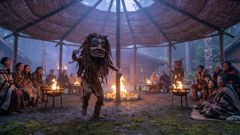
But the stories of dread are only one side. Another recurrent motif describes villagers waking to find riches deposited at their door—bundles of blankets, stored fish, or boxes of shell money. Rather than simply being a benign gift-giver, the Dzunukwa’s bequests often come after a demonstration of respect. A family who has carefully cut cedar in the proper place, who has given thanks at the appropriate point in the harvesting season, or who has shown care in raising children might be the recipient. The gifts, therefore, are not unconditional. They are the nod of the wild world to those who maintain relationships with it. Stories emphasize small rituals: an offering of tobacco left at a stump, a whispered name, the sound of ceremonial drums at dusk. In this sense, the Dzunukwa is a literary embodiment of ecological reciprocity: communities that reciprocate receive abundance; those who take thoughtlessly face hunger or loss.
There are also trickster-crossover tales where younger community members outwit the Dzunukwa. In one retelling, a brave youth ties a bell to a small animal or crafts a decoy, causing the Dzunukwa to stumble and reveal a cache of objects. The youth returns with a trunk of carved masks and blanket rolls, which then become the subject of a potlatch—redistribution that reaffirms communal ties. Such stories do important social work: they narrate how wealth is obtained and shared, how one’s bravery or cleverness can restore balance, and how the community turns a potentially selfish windfall into a public resource. This is crucial because wealth on the Northwest Coast—traditionally expressed in blankets, carved treasures, and shell rings—was rarely hoarded by a single household; it circulated through potlatch ceremonies that affirmed status and responsibility. Thus, stories of the Dzunukwa depositing wealth that is then redistributed function as allegories for just society.
In the contemporary era, the Dzunukwa’s face has moved into new media: carved museum pieces, theater, films, and written retellings. That movement has been complicated by colonial histories. For generations, Indigenous practices were suppressed, and many stories were taken out of context and shown in museums without the cultural frameworks that gave them life. Recent decades, however, have seen a resurgence of Indigenous storytelling authority. Elders, artists, and scholars have reclaimed the Dzunukwa and related figures, using them to teach both community and outside audiences about stewardship, the importance of cultural protocols, and the dangers of commodifying sacred narratives. Modern retellings often emphasize community resilience: the wild woman becomes a figure to challenge extractive economics and to remind listeners of the obligations that come with wealth.
The symbol of the Dzunukwa has also found usage in ecological and social critique. Poets and environmental writers draw on the wild woman as a metaphor for a nature that cannot be owned, reminding readers that the forest is not merely a resource but a network of life bound by rules we may not fully know. Activists point to the Dzunukwa when arguing for Indigenous land rights and for recognition of traditional ecological knowledge—knowledge formed by centuries of interaction and ritual that colonial law too often disregarded. In these contemporary framings, the figure becomes both a guardian and a witness: she sees what the settlers would not and remembers the transactions overlooked by modern accounting.
Because the Dzunukwa legend is layered, it also opens space for personal and artistic reflection. For some Indigenous storytellers the Wild Woman is a mirror of the pain of displacement and the longing for ancestral lands, a character whose hunger is the hunger of people forcibly removed from their resources. For others she is an agent of empowerment: a reminder that the forest holds its laws and that outsiders who learned to listen could be welcomed. Artists have reimagined her form—not as a static caricature but as a shape-shifting presence whose hair becomes kelp, whose hands hold sap and shell, whose eyes gather ceremony. In theater, the Dzunukwa’s movements can be both grotesque and graceful, walking the line between monstrous and deeply rooted in the place she protects.
Even the darker facets of the tale require careful attention. The element of cannibalism, frequently emphasized in outsider retellings for shock value, is a motif that must be handled with cultural sensitivity. Within Indigenous contexts it often functions as a symbol—an archetypal threat used to mark boundaries and to teach children about danger. Taken out of cultural context and sensationalized, the motif can perpetuate harmful stereotypes. Thus, contemporary storytellers often work to balance frankness with respect, naming the fear while refusing to make spectacle of the figures whose stories have sustained communities for generations.
To encounter the Dzunukwa in story is to accept a deliberately ambiguous moral. She can be a punishment for greed or an unexpected source of abundance; she is a reminder that human communities are not exempt from the rules of reciprocity that govern the rest of the natural world. Her legend insists on a relation: how we approach our world matters, and attention, ritual, and humility are often the price of a safe passage. When a family following traditional practice offers thanks and leaves a small gift at the threshold of the cedar grove, they do not merely ward off danger; they participate in an exchange. The Dzunukwa’s gifts and losses are not arbitrary; they are responsive. For those who listen—those who learn to watch the wind, to read the turn of tides, and to respect the cedar’s slow pulse—her story remains an alive, instructive presence.
Conclusion
The legend of the Dzunukwa endures because it names an ancient grammar of relationship: the forest gives and the forest warns; treasures appear only in a ledger of respect. In the cedar shadows of the Pacific Northwest, the Wild Woman acts as both admonition and ancestor—an embodiment of the consequences of greed and the rewards of reciprocity. When told at firesides or enacted in ceremony, her story reinforces the obligations that bind people to the land and to one another: to offer thanks before taking, to teach young ones prudence, and to share gained wealth through community ritual. Contemporary reclaiming of the Dzunukwa illuminates how Indigenous storytelling continues to shape conversations about stewardship, cultural survival, and ecological knowledge. The figure resists being simplified into mere monster or treasure-bringer; she is a complicated, living voice that insists on attention and humility. To hear her is to remember that wealth without ceremony can swiftly become peril, and that the old woods keep accounts older than paper. In honoring those protocols—listening to elders, tending salmon runs, cutting cedar responsibly—people do more than avoid appetite: they sustain a way of life that the Dzunukwa has long enforced and, at times, benevolently augmented. Her legend, carried forward responsibly, remains a map: not of geography, but of conduct, reminding us that the wild is never without memory, and that reciprocity is the oldest currency.






